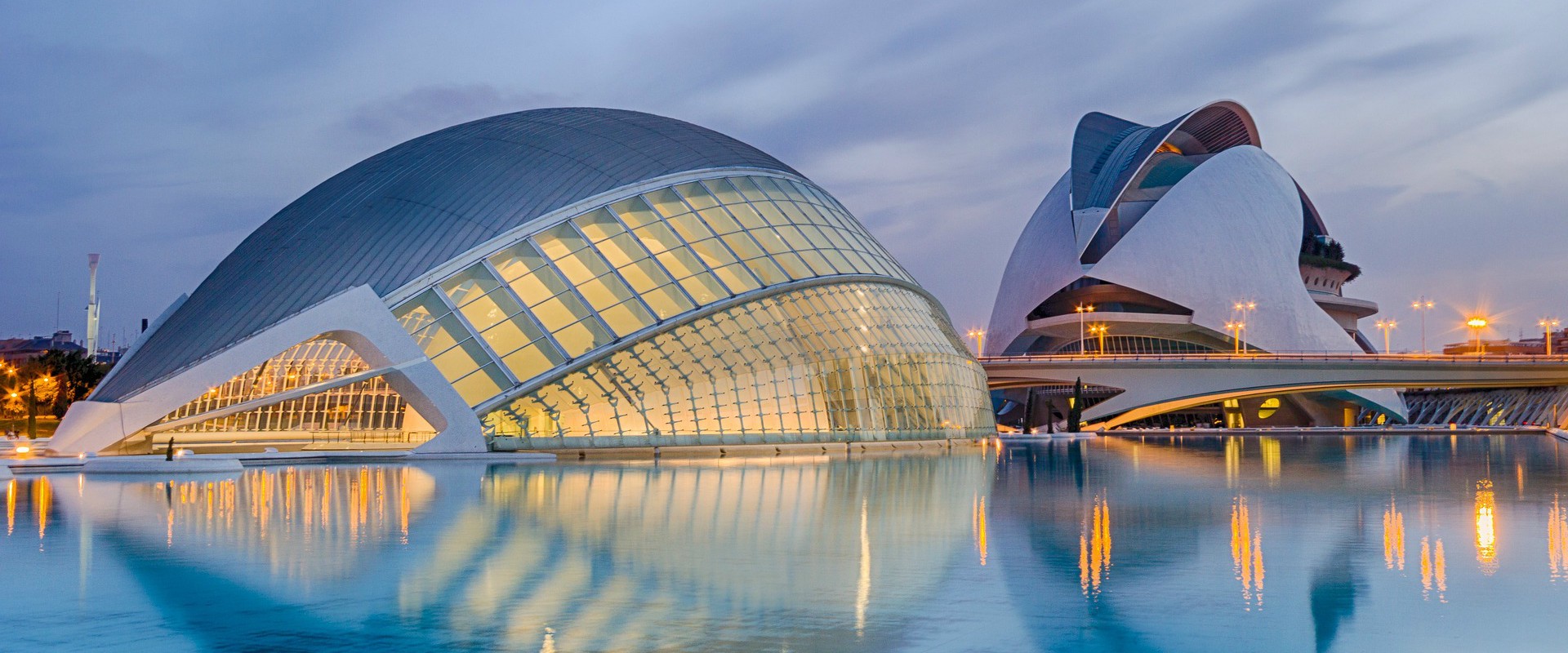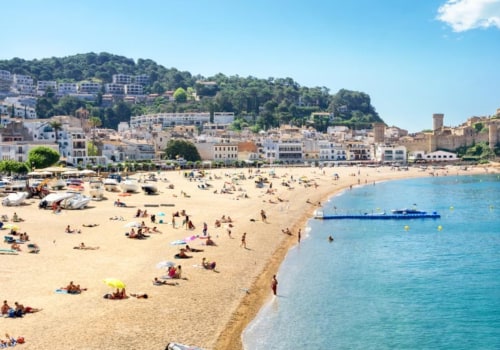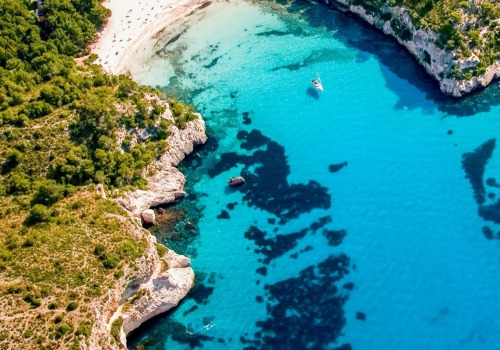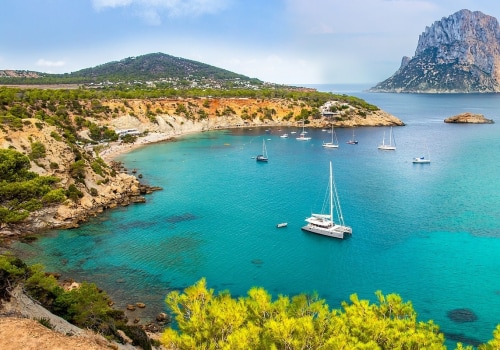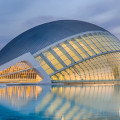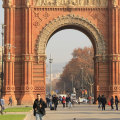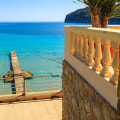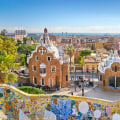Alhambra and Generalife Gardens, Granada · 2.Places of the Sagrada Familia and Gaudí in Barcelona · 3.The Great Mosque of Cordoba (Mosque) · 4.The Gardens of the Alhambra and the Generalife, Granada The Great Mosque of Cordoba (Mosque) Construction materials of Roman and Visigoth buildings were used in the construction, which began in 785, and by 1000, it had grown to its current dimensions, its prayer hall with no less than nineteen corridors. No matter where you are or in which direction you look, its rows of columns and rounded Moorish arches line up in symmetrical patterns. San Lorenzo de El Escorial, about 45 kilometers northwest of Madrid, was the summer home of the kings of Spain, and in 1563, work began here on a huge complex, which would include a monastery, a church, a royal palace, a mausoleum, a library and a museum, all conceived as a monument to Philip II and his reign. The result is an impressive collection of attractions, built around 16 courtyards, their rooms and structures connected by 16 kilometers of corridors.
At its core is the church, whose highlight is the 30-meter-high altarpiece of Herrera, made of jasper and red marble and accessed by a stretch of 17 steps. La Giralda tower, Seville Cathedral and Alcázar combine to form a UNESCO World Heritage Site. The tower is a minaret, a masterpiece of Almohad architecture, according to UNESCO. The cathedral has more interior space than St.
Peter in Rome and a 37-meter high altar of carved statues completely covered with gold. The opposite Alcazar was started by the Moors in 712 and continued after the Christian reconquest by King Pedro in the 1300s in the ornate neo-Moorish style called Mudejar. The rooms and lounges are stunning, and the gardens are a pleasure to stroll, shaded by fragrant orange and lemon trees. To the east is Santa Cruz, the old Jewish Quarter, a neighborhood of whitewashed houses, iron balconies and courtyards full of flowers.
One of the most outstanding monuments of early Romanesque architecture, the cathedral was built between 1060 and 1211, and despite the Baroque transformation of the exterior in the 16th to 18th centuries, the interior remains in the purest early Romanesque style. You'll see these two periods at play as you enter the western front, through one of the most impressive church facades in Spain. Enter to look towards the Portico de la Gloria, part of the old west front now hidden by the 18th century façade. This triple door is one of the largest and most magnificent collections of Romanesque sculpture in the world.
The heartbeat of Spain's vibrant capital, Plaza Mayor, has played an important role in Madrid's life since the 16th century, when Philip II entrusted the task of designing it to his favorite architect Juan de Herrera, builder of El Escorial. Built for the Ibero-American Exhibition of 1929 to celebrate the regions of Spain, the Plaza de España is an impressive semicircular pavilion surrounded by colonnades. Beautiful panels of colored tiles representing each of the provinces of Spain overlook the long swimming pool, which is crossed by bridges. It's a popular spot for strolling or paddling on a rental boat around the pool and under bridges.
The largest and most lively beach is Playa Inglés in Maspalomas, which abounds with cafes, restaurants, shops, playgrounds and other attractions. At one end is one of the natural wonders of the archipelago, a vast protected area of gigantic sand dunes. These reach a height of up to 12 meters and change constantly as they are shaped by the wind and the sea. To complete the illusion of the desert, you can ride a camel through this desolate and unearthly landscape.
You can explore El Teide in several ways. You can drive or walk inside the caldera, the crater floor, 12 miles in diameter and an arid lunar landscape of colorful rock formations that is like driving towards the center of the earth. You can climb the Teide cone, but an easier way to get close to the top is by taking an eight-minute cable car ride. On a clear day, the views cover the entire archipelago and can extend to North Africa, the closest land mass to the Canary Islands.
The most spectacular is Arcos de la Frontera, whose square next to the Gothic church ends vertiginously on a 137-meter cliff, which overlooks a valley of olive, orange and almond trees. Its labyrinth of winding cobblestone streets lead to cafes and craft shops selling pottery and ceramics to a Moorish castle. A total of 19 of these villages with small white houses are located in the vicinity of the Grazalema Nature Reserve. Grazalema and Zahara de la Sierra are two others worth seeing.
A good starting point in the region is Jerez de la Frontera, home of flamenco and Andalusian thoroughbreds. See the precision ballet of these horses at the Royal Andalusian School of Equestrian Art and, to enjoy authentic flamenco, visit the Flamenco Cultural Center. Few tourist destinations in the world offer such a dazzling variety of sights to see and tourist attractions to visit as Spain. This European country is also full of stunning natural landscapes and beauty, from the rugged Sierra Nevada mountain range to the white sand and blue lagoons of its Mediterranean islands, such as Ibiza.
No visit to Madrid is complete without visiting the three main museums in the city. The Prado Museum (officially called the Museo Nacional del Prado) displays what was once the royal collection of Spanish art, while the nearby Reina Sofia Museum showcases modern masterpieces such as Picasso's moving Guernica. In addition, the nearby Thyssen-Bornemisza Museum combines Old Masters with the best of contemporary art. Madrid is also a classic European city for walking, full of green spaces to enjoy, such as the Buen Retiro Park, as well as wide pedestrian boulevards, such as the iconic Gran Vía.
Food culture thrives here too, from casual tapas-tasting cuisine to cutting-edge Michelin-starred molecular gastronomy. The second largest city in Spain offers a completely different travel experience than in Madrid. Its coastal location gives it a more resort-like feel, with a warm and sunny climate to enjoy most days of the year. It is on the northeastern coast of the country, next to the Mediterranean Sea, and it also seems to have a much more modern and progressive atmosphere than Madrid and other Spanish cities.
Barcelona's must-see tourist attractions include the city's immense (and perpetually unfinished) modern Sagrada Familia cathedral and the Joan Miro museum, conceived by the iconic artist himself before his death. Other good places to see in Barcelona include the city's nearly three miles of beaches and La Rambla, a huge tree-lined and pedestrian-only street. It's where it seems that the whole city goes for a walk. Continue to where La Rambla meets the water and you will find the Maremagnum shopping center.
It is on its own artificial island, almost completely surrounded by water. You get there by walking along a very cool wooden drawbridge, called Rambla de Mar. It opens every hour to allow sailboats and yachts to pass. Head to La Terraza, the shopping center's panoramic platform with 360 degree views of the water and the city skyline.
The large aquarium of the city is next to the shopping center on the same small peninsula and is well worth a visit. This tourist city is located on the north coast of Spain, in the Basque region. San Sebastian is right on the picturesque Bay of Biscay, which opens onto the Atlantic Ocean. It is a popular surf town, with a great surf scene in Zurriola Beach.
A visit also provides an opportunity to experience the unique Basque culture. Valencia is a port city with a long connection with the sea and with Spain's trade with the world, especially with Europe, the Middle East and Africa. It is in the Mediterranean Sea, on the southeast coast of the country. As a coastal city, there are some nice beaches to enjoy.
Another outdoor spot to see is Parque de la Albufera, a wetland reserve next to the beach with lots of hiking trails (and some good beaches). The Museum of Fine Arts (Museu de Belle Arts de Valencia) stands out, with its excellent collection of Spanish masters by artists such as El Greco and Goya. There is also a large Gothic-style cathedral in the medieval center of the old city, along with remains of the ancient city walls. Be sure to visit the Torres de Serranos, one of the only permanent gates to the walled city and a prison for more than 300 years.
The National Museum of Ceramics and Decorative Arts, González Martí, is full of interesting things. The Spanish decorative arts are in the spotlight here, with an incredible collection of ceramics, traditional costumes and furniture. Kids will love the Museum of Natural Science and its large collection of dinosaur skeletons. When you're hungry, head to the city's Central Market, a huge Art Nouveau market (built in 191) filled with food vendors and cafes (along with souvenir shops and other tourist-type businesses).
Although it's a popular tourist attraction, you'll also be surrounded by locals, as this is where they go to eat and hang out. Granada, home to the spectacular Moorish fortress and palace on the top of a hill in the Alhambra, is another vibrant destination in the southern region of Andalusia. It has more incredible examples of Islamic architecture, including the Alhambra castle complex. There is a whole preserved area of the Moorish old town called El Albaicín, with narrow streets and most of the buildings dating back to the 8th, 9th and 10th centuries.
It is a great tourist destination, since you can experience ancient and modern Spain in the same place. There is a large university in Granada and a thriving modern cultural world, with delicious food, places to go for tapas and flamenco music and dancing. Real Spain is represented here with an ornate 16th-century cathedral, which houses the tombs of King Ferdinand and Queen Isabel, who united the country (and sponsored Christopher Columbus's discovery trips). One of the best holiday spots in Spain for couples is the tourist island of Ibiza.
It's a short flight or ferry ride of five to six hours and it's about 100 miles off the Spanish coast. Ibiza is the largest of the Balearic Islands, a group of mainly tourist islands in the Mediterranean Sea. The other three larger islands, Mallorca, Menorca and Formentera, are also popular places to see in Spain. Ibiza may be best known for its electronic music, beach parties and massive dance clubs, but it's also filled with lots of fantastic family resorts and lots of fun things to see and do with children.
It has something for everyone and is a good destination for singles, couples and families. Ibiza's tourist areas include Portinatx in the north, San Antonio in the west and Santa Eulalia in the east. This ancient city in the Andalusian region, in southern Spain, allows you to explore the history of Spain, which dates back several thousand years, when it was part of the Roman Empire. Cordoba was an important Roman city (called Corduba), and there are still many preserved Roman ruins and sites, including a 16-arch bridge over the Guadalquivir River.
The Archaeological Museum of Cordoba presents the history of the city (and of Spain) that dates back thousands of years. An additional attraction, the museum is located on the site of the ancient Roman theater of Córdoba. The theater has been excavated and can be visited in the basement of the museum. Seville, a beautiful and fascinating city in southern Spain, is another example of the country's living history.
It is a compact city, ideal for sightseeing, full of Roman ruins, Moorish structures and palaces and Gothic churches of the Castilian domain (the period when Spain was ruled by kings and queens). Islamic history and culture are especially rich here, as the city was the capital of the ruling Moorish dynasty for most of the time it was under its control. It also flourished during Spain's Golden Age, between the 15th and 18th centuries, when it was the only port that was allowed to officially receive trade from the Spanish colonies in the Americas. Music and dance are also taken very seriously here, as Seville is home to flamenco dance and related musical style.
You can enjoy flamenco in Tirana, a neighborhood full of small cafes and entertainment venues. Santa Cruz is another popular area to explore; it is home to the city's huge Gothic cathedral and the royal palace complex, called the Real Alcázar. The palace, originally built for the Islamic rulers of the city, is a true living history, as the current Spanish royal family uses it when it is in the city. This city in northern Spain is the capital of the Basque region, which may look like a different country.
It is part of Spain but is officially considered an autonomous community. The language (also called Basque) here is different from other parts of Spain, as is food, music and culture in general. The opening in 1997 of the incredible curvy, titanium-clad Guggenheim Museum designed by Frank Gehry really put this ancient industrial port city on the map of world tourism as a must-see spot in Spain. Another great holiday spot in Spain is the stunning Costa Brava area of Catalonia.
It is located on the north coast of the Mediterranean of the country, north of Barcelona, extending to the border with France. It is full of small beaches, rugged cliffs and many small coves, bays and coves. The most popular tourist towns on the Costa Brava include Blanes, Tossa de Mar and Lloret de Mar. Take a day to explore (and snorkel) in the uninhabited Medes Islands, just a short boat ride away.
The Spanish city of Segovia is located in the center of Spain, northwest of Madrid. The area is rich in Roman ruins and was also a key city in the post-medieval period of royal rule. There is a Gothic cathedral (with a fascinating museum of religious art) located in the Plaza Mayor of the city. The Plaza Mayor area is a paradise for food lovers, as it is full of restaurants, cafes and places to have tapas.
Sights in Segovia include the fortress and castle of the Alcázar Moro, which was believed to have been an inspiration for Walt Disney when he created Cinderella Castle for its theme parks. Other must-see attractions include the city's incredible two-story ancient Roman aqueduct and the city's massive 16th-century Gothic cathedral. With the ruins of a Roman amphitheater and a roman circus car racing track, Tarragona is one of the best places to see remains of the ancient Roman world in Spain. It is a port city in the region of Catalonia, located in the northeastern part of the country.
Known as Tarraco in ancient Roman times, the city has a 2nd century arena, a necropolis of Roman tombs, and even preserves vestiges of the ancient forum. All this Roman history exists in and around the medieval walled area of the old town. The Museum of the Andrés Segovia Foundation, housed in a restored 17th century palace, shows the life of Segovia, allowing visitors to see its music, instruments and other personal belongings. The museum also contains a crypt with the tomb of the Master.
Linares is a city in the region of Andalusia, about 90 minutes by car from Cordoba or Granada. The Abama Golf complex offers players the opportunity to play a game on the slope of a volcano. Playing the field feels like exploring a botanical garden with more than 300 species of subtropical plants, combined with more than 20,000 palm trees and 22 lakes. The main attraction here (apart from the challenging route) are the views.
The entire course is elevated, and almost all the holes have postal views of the Atlantic Ocean and the neighboring island of La Gomera. In addition to golf, the resort offers luxurious accommodation, multiple dining options and a first-class spa. Pamplona is a city in Navarra, famous for its San Fermín festival that is held every year from 6 to 14 July. At the heart of the festival is El Encierro, el encierro, an activity that consists of running in front of a dozen bulls that have been released, on a tour of the streets of the city.
Protected from strong winds by steep cliffs and islands, many say that La Concha, in San Sebastián, is one of the best urban beaches in Europe, let alone in Spain. Here you can surf, stroll along the promenade in search of good restaurants and enjoy the beautiful views of the beach. The Aqueduct of Segovia is one of the best preserved monuments left by the Romans in Spain. The old aqueduct carries water 16 km (10 miles) from the Frio River to Segovia and was built with about 24,000 solid granite blocks without the use of mortar.
Probably built around 50 AD, it still provided water to the city in the 20th century. Located between Madrid and Valencia, Cuenca is a wonderful example of a medieval city, built on the steep slopes of a mountain. The numerous “hanging houses” are built to the edge of the cliff, making Cuenca one of the most striking cities in Spain, a jewel in the province of Castilla La Mancha. Ibiza is one of the Balearic Islands in the Mediterranean Sea, off the coast of Spain.
The island is one of the most popular party destinations in all of Europe. During the summer, the island's population doubles as tourists flock to Ibiza to enjoy nightclubs, beach bars and restaurants. Located in the foothills of the Sierra de Guadarrama, El Escorial was the political center of the Spanish empire under King Philip II. Philip named Juan Bautista de Toledo an architect in 1559 and together they designed El Escorial as a monument to the role of Spain as the center of the Christian world.
Nowadays it works as a monastery, royal palace, museum and school. Part fortress, part palace and part garden, the Alhambra is situated on a plateau overlooking the city of Granada, in southern Spain. The palace was built in the 14th century by the Nasrid sultans. The Alhambra is now one of the main tourist attractions in Spain and many visitors come to Granada just to see the Alhambra.
There is never a day when the Prado Museum is not full of gawking tourists. This museum houses the largest collection of Spanish and European art, of impressive medieval works from the 12th century and avant-garde movements. Works by artists such as Goya, Raphael, Rubens and Velázquez can be found here. The visit to Madrid is not complete without visiting the historic Plaza Mayor.
This large public space serves as the venue for several ceremonies, including the proclamation of a new king, the burning of heretics, the canonization of saints and cavalry tournaments. The Gothic architecture of Cuenca Cathedral is one of the main attractions in Spain. Originally built in the 12th century, this attractive monument houses the precious remains of the founding bishops and members of the Montemayor family. Tourists visit this cathedral to see the 18th century altar, the Renaissance-style arch of Arco de Jamete and the intricate carved wooden ceiling.
The church also hosts art exhibitions and other private events. When visiting Cuenca, it's hard to miss this cathedral because it's conveniently located in the central Plaza Mayor. High on Barcelona's skyline is the historic Sagrada Familia, designed by Catalan architect Antoni Gaudí. The construction of this Roman Catholic church began in 1882 and is one of Gaudí's most famous works.
The basilica can accommodate about 14,000 people inside and is 170 meters high. The medieval fortress located on a plateau is the Alhambra Palace itself in Granada. Built in the 14th century by Nasrid sultans, this infrastructure represented Spanish civilization in the Middle Ages. Construction of the palace began in 712 and continued after the conquest of King Peter in the 1300 century.
In addition to the exterior, the rooms and living rooms are impressive, with neo-Moorish details throughout. The garden is also a must see, nestled in fragrant orange and lemon trees. It is only in Barcelona that tourists can find a Gaudí public park of more than 17 hectares in size. Famous for its glamorous terrace, iconic entrance and curved stone columns, this museum showcases some of Gaudí's works.
The museum houses the iconic dragon staircase, the hypostyle room, the Austria gardens and the portico of the laundry room. Perfect for a walk in the open air, Park Güell receives an annual tourist count of around 12 million, who come here for the architectural wonder. The lush environment combined with unconventional infrastructure, this public park is considered a work of art. UNESCO added Park Güell as a World Heritage Site in 1984, which served as one of the cultural assets existing today.
What is Spain famous for? 10 best-known things in Spain. El Teide, Tenerife, is a mountain range with a volcano, which acts as a central point of attraction. Barcelona is the most visited city in Spain, and the Basilica of the Sagrada Familia is the most visited tourist attraction in the country. The last thing you want is to miss the opportunity to see the buildings or attractions that you are passionate about, because there are a lot of people and the attractions are at their capacity.
With access to the fascinating beach, visitors couldn't deny that Ibiza is one of the best tourist attractions in Spain. Not only the buildings, but the museums, the art rooms and the aquarium (by Félix Candela and the only building not designed by Calatrava) form a series of tourist attractions that are among the most popular in Spain. The main attractions include the Molinos Museum in Taramundi, Cabo Vido, Lake Covadonga and the Sanctuary of the Virgin of Covadonga located in Cangas de Onís. The Mosque of Cordoba, also known as the Great Mosque of Cordoba, is one of the main attractions of the city.
Whether it's a sun-drenched beach or an artistic highlight of European culture or a biogeographic garden courtyard, Spain has all the attractions to entertain travelers who come to experience Spanish extravagance, coming from all over the world. Be sure to visit the best attractions in Spain between March and May for colorful festivals, a sea of fun-loving locals and fewer crowds. A wonderful symbol of Spanish culture, flamenco is something that many tourists look forward to when they visit the country. With a mile-long stretch of pristine white sand and sunbeams covering the entire coastline, the beaches of the Costa del Sol offer sun and sand retreats for tourists.
Tourists and locals alike flock to Retiro in good weather to escape the hot sun, either in the shade or to sunbathe. The park is based on a series of the best Warner Brothers movies, and its attractions are inspired by many well-known characters, including the favorites of superheroes, Superman and Batman, the great cartoons Tom and Jerry and Scooby-Doo, and the adorable rogues of Acme. Considered one of the “12 treasures of Spain”, Ciutat de les Arts i les Ciències is one of the main attractions in Valencia. .
.
